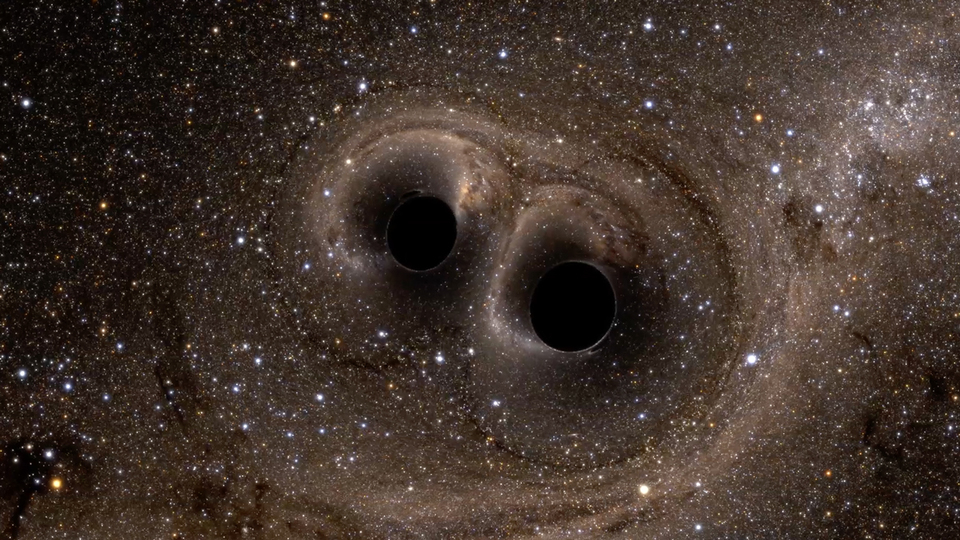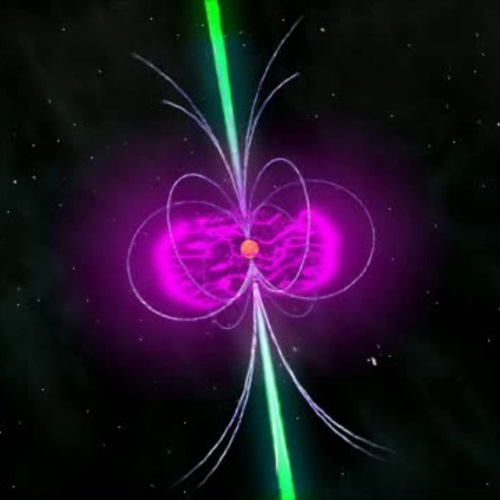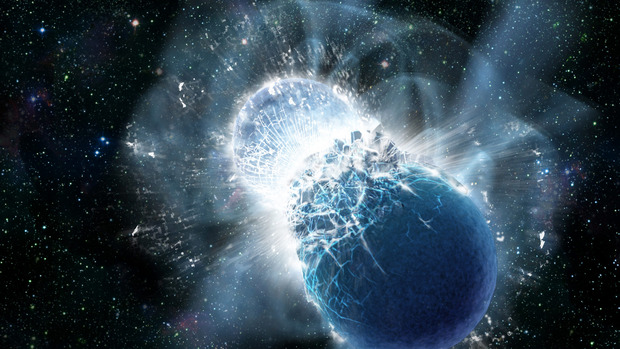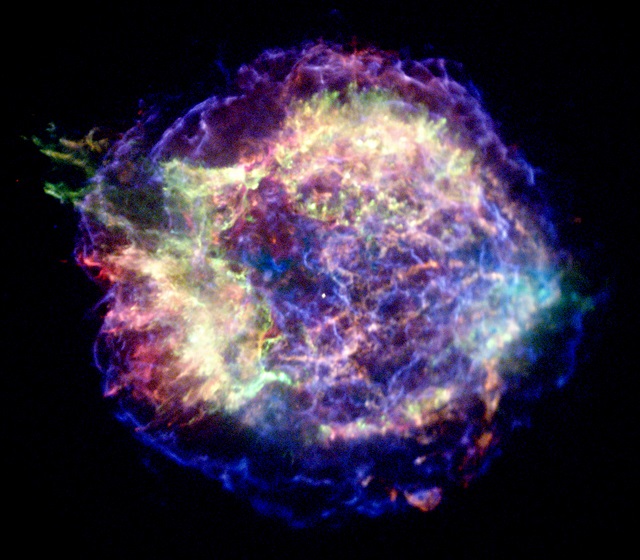Gravitational Astrophysics
Gravitational Radiation
Introduction
The detection of gravitational radiation, first by LIGO in 2015 and later by Virgo, has initiated a whole new branch of astronomy: observational gravitational astrophysics. The Institute for Gravitational Research in the University of Glasgow is at the forefront of exploring this new field. We have been deeply involved both in developing the sensitive methods used by the LIGO-Virgo collaboration to detect signals, and in the astrophysical interpretation of these new and exciting results. The latest results from LIGO can be found at the collaboration website, and some of our Glasgow activities are described below.
Black holes

What are black holes
Black holes are regions of spacetime where gravity is so strong that even light cannot escape its grasp. Their masses range from a few times that of the sun (stellar mass BHs) to billions of times that of the sun (Supermassive Black Holes).
How are they formed
Astrophysical black holes are formed through the collapse of matter under its own gravity. Stellar mass black holes are the end-point of the evolution of very massive stars (tens of times solar mass). When these stars have burned through all their fuel they can no longer generate enough pressure to counteract their own gravity, and the dense core collapses inward until it forms a black hole.
Fundamental properties
Black holes are of special interest in the study of gravity because they are theoretically very simple objects, described by only three quantities: their mass, spin and charge. Their strong gravity also provides us with the ideal laboratory to study the dynamics of the gravitational field, and compare our observations with the behaviour predicted by general relativity.
What has LIGO seen?
When two black holes are in orbit around each other, they produce gravitational waves which carry off energy and will lead them to eventually collide. In the final fractions of a second these waves become detectable by the ground-based gravitational wave detectors Advanced LIGO and Advanced Virgo. These signals led to the discovery of a population of black hole binaries with masses tens of times that of the sun. As the sensitivity of the detectors is improved we will discover many more of these binaries, which will allow us to better understand their population.
What astrophysics can we do with them?
We can explore the ways in which such massive black holes are formed, from the evolution of even more massive stars. Understanding the statistics of the population will tell us how different pathways contribute to these types of systems.
Higher mass BHs in LISA and PTAs
As well as the stellar mass black holes that have been discovered through gravitational waves so far, there are also efforts to detect the signals from supermassive black holes too. These huge systems produce signals with much longer wavelengths, and require much bigger detectors. The LISA space-based detector with 5 million km arms is designed to detect the merger of supermassive black holes that should happen when galaxies collide. To go even larger we need a galactic-sized detector, which we can create by precisely timing the signals from an array of pulsars. Such Pulsar Timing Arrays will probe the background noise of all the supermassive black hole binaries in the universe.
Stellar evolution, GR ...
Neutron stars
Our ground-based detectors are sensitive to gravitational signals with frequencies down to about ten hertz and as high as several kilohertz. Any source capable of generating such signals must be changing the configuration of its mass at similar rates. Furthermore, to generate a signal we can detect, the masses involved must be huge -- similar to the mass of the Sun or larger. Binary black holes, described above, fit this recipe well, but are not made of matter in the conventional sense. We do however know of a type of compact object made of an extreme form of matter capable of withstanding these immense forces: neutron stars. These are the most extreme forms of matter known -- more than the mass of the Sun compressed into a rapidly-rotating and highly-magnetised sphere, around 20 km in diameter. Neutron stars are thought to be quite common, possibly a billion in our Galaxy alone, but we know of only about 2600 at present.
Spinning neutron stars

Rapidly spinning (up to over 700 rotations per second) neutron stars were first positively identified 50 years ago as radio pulsars and have been the topic of intense scrutiny ever since. If a pulsar is slightly misshapen around its axis of spin it will generate a continuous stream of gravitational waves related to its spin frequency, like a gravitational 'spectral line'.
The University of Glasgow leads the worldwide effort to detect gravitational waves from such pulsars. Guided by radio and X-ray pulsar observations we look for these weak spectral lines in the gravitational data. We combine gravitational observations taken over several years to carry out the most sensitive strain measurements achieved by LIGO, around 10-26.
Binary neutron stars

Spinning neutron stars should generate a weak gravitational signal. However we know of several examples of binary neutron stars ('BNS's, i.e., two neutron stars in a close orbit around each other) that open up a new possibility. As with binary black holes, the orbit of a BNS system will decay by gravitational radiation and eventually the two stars will collide.
In Glasgow we are deeply involved in the hunt for, and astrophysical interpretation of, gravitational signals of BNS mergers. These feature-rich events are some of the most important observations that ground-based gravitational telescopes can make. Neutron star matter is strong enough to withstand the immense forces involved until the final few orbits, when the stars get distorted and finally ripped apart in the final merger. A BNS merger generates a powerful burst of gravitational waves in our sensitive band, and the precise waveform contains unique information on the makeup of the neutron stars themselves. This is an extreme form of matter than only exist under unimaginable pressure -- enough, at the centre of the star, to crush an aircraft carrier to the size of a grain of sand. However neutron stars are made of the same elementary particles that we study in nuclear and particle physics and so promise a unique insight into the nature of matter.
Supernovae and the unknown

When a massive star reaches the end of its life, it can no longer support the material in its outer layers and this outer material begins to collapse towards the star's core. This Core-Collapse Supernova marks the violent death of a massive star. These explosions, which can briefly outshine an entire galaxy, are some of the most spectacular events in our Universe. When a star explodes relatively close by, e.g., in our own Milky Way Galaxy, then its light can be visible even without a telescope, and a "new" star appears in the sky. In addition to the light, these cataclysmic events will also produce a burst of gravitational waves, and in Glasgow we have a research programme tuned to detecting such signals.
This is a very short, violent and important phase lasts only milliseconds but could be observed with optical telescopes throughout much of the Universe. The light emitted by Core-Collapse Supernovae provides us with a lot of information about the progenitor of the explosion. However, the light from star's center cannot plough through the surrounding material, so from electromagnetic observations of the Core-Collapse Supernovae alone all information about the collapsing core is lost. Gravitational Waves, on the other hand, can provide insight into the dynamics of the collapsing core. Gravitational waves can escape from the collapsing core, without being scattered or absorbed by the dense outer layers of the star, and in principle we can detect these with LIGO and Virgo.
These explosions are also of interest because many common chemical elements we see around us were actually produced in a Core-Collapse Supernova, all four fundamental forces play a role, and the full equations of Albert Einstein's General Theory of Relativity have to be considered. All the processes leave an imprint on the gravitational wave signature emitted by the Core-Collapse Supernova, however the rich complex physics occurring during the event is very difficult to simulate and computationally very expensive. Therefore, detecting gravitational waves from Core-Collapse Supernovae will be a breakthrough discovery that will enhance our understand of the astrophysics behind this highly energetic phenomena.
Multi-Messenger Astronomy
Some of the strongest sources of gravitational waves will also produce enough light to be visible from ground and space-based telescopes across the electromagnetic spectrum. As described above, BNSs release a great deal of gravitational-wave energy as the neutron stars spiral together. During the merger phase the stars produce highly radioactive material as well as an accompanying burst of gamma-rays, thought to come from narrow jets of high-energy radiation that blast from the merging stars for about one-tenth of a second. Gamma-ray bursts are some of the most energetic events in the Universe, typically releasing as much energy as our Sun will emit throughout its entire life but in just a few seconds.
If we can see the gravitational signature of a binary merger then we can determine both the characteristic mass and its distance from us. This is a very unusual property of these inspiral signals. If we can also measure the speed at which that binary is travelling away from us as the Universe expands, by analysing the redshift of its optical spectrum, then we can measure the expansion rate of the universe, known as Hubble's constant (H0). In Glasgow we carry out research into this unique method of determining H0 using our combined local expertise in cosmology, data analysis and gravitational wave astrophysics.
There are also other possible signatures. Radioactive material ejected during the neutron star merger glows as it decays, emitting optical and infrared light for a few days after the merger. This phenomenon is called a kilonova or macronova and is 100 billion times dimmer than a gamma-ray burst. In addition to the light and gravitational waves, the process which produces the radioactive neutron-rich material could also be the source of gold and other heavy elements found on Earth. Most of the lighter elements in our bodies (like carbon and oxygen) were likely created in supernovae, but the source of heavier elements is still a mystery - one that could be solved by observing light and gravitational waves together. While it's true we are all made of star stuff, your gold ring may be made of neutron-star stuff!
The rich phenomenology associated with binary neutron star mergers mean their observation and study impacts a broad range of physics. They are excellent particle physics laboratories, providing far more extreme conditions to probe the properties nuclear matter than what can be achieved in a terrestrial laboratory. They are also one of nature's richest sources of multi-messenger emission, covering the full EM spectrum, producing gravitational waves at both low and high frequencies, and are likely sources of high-energy neutrino emission, opening up possibilities for astro-particle astrophysics.
These new cosmic messengers have heralded the dawn of a new era of multi-messenger astronomy, where we can listen to a symphony of cosmic gravitational waves while observing the full splendour across the electromagnetic spectrum, from radio waves to high-energy gamma-rays, all emitted by the most extreme and exotic phenomena in the Universe.
